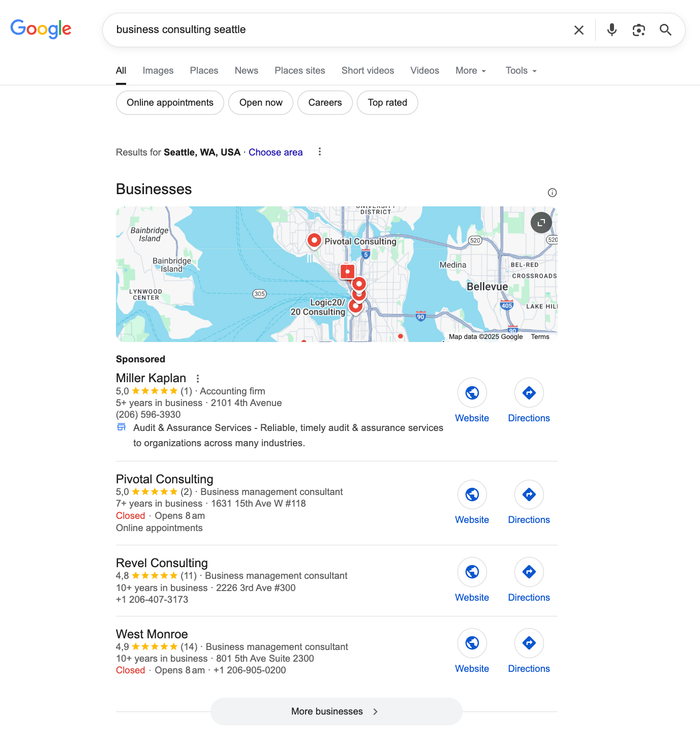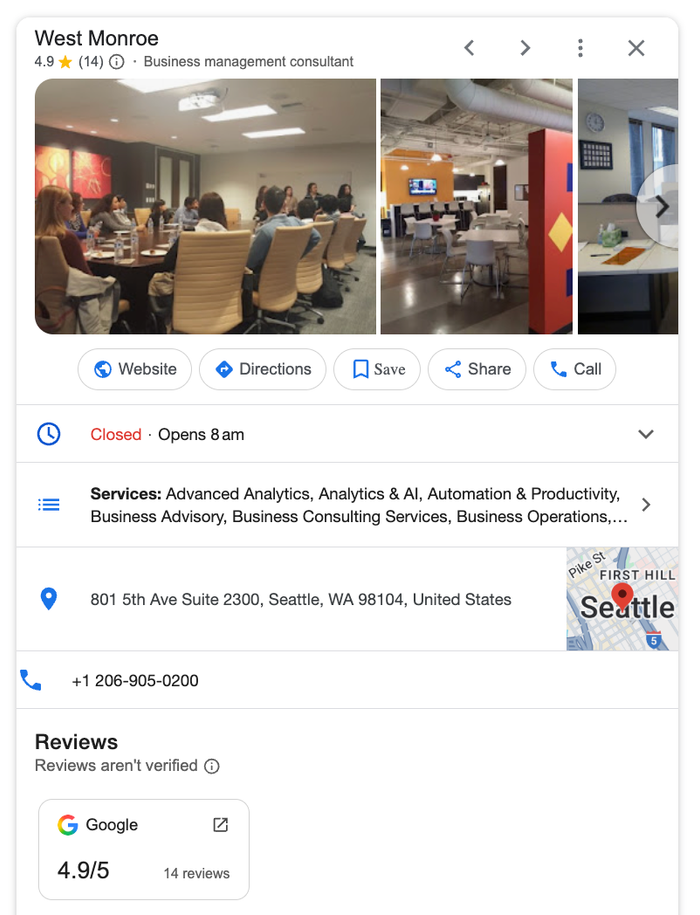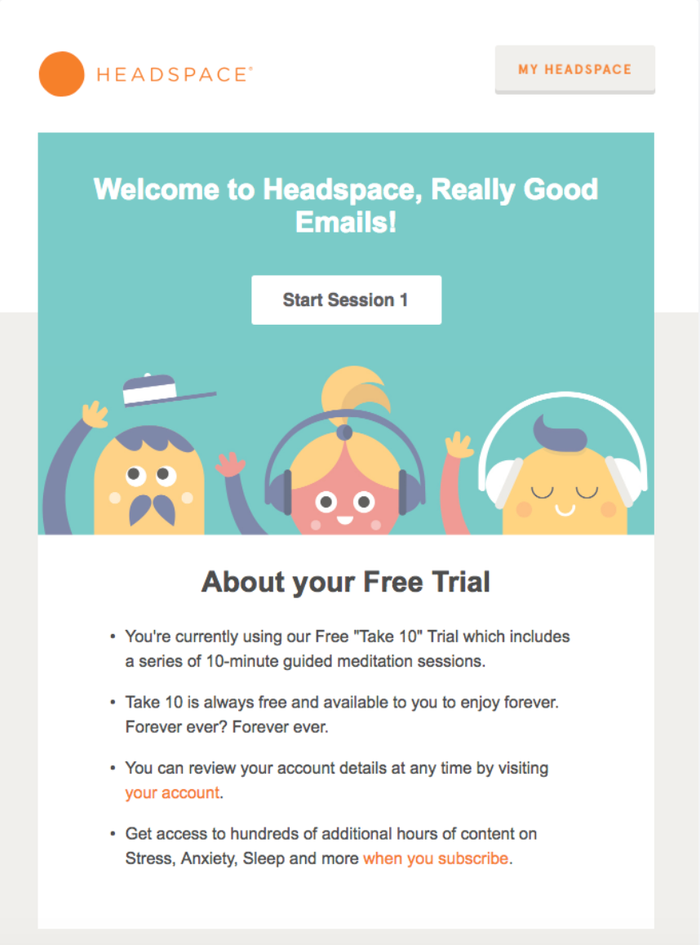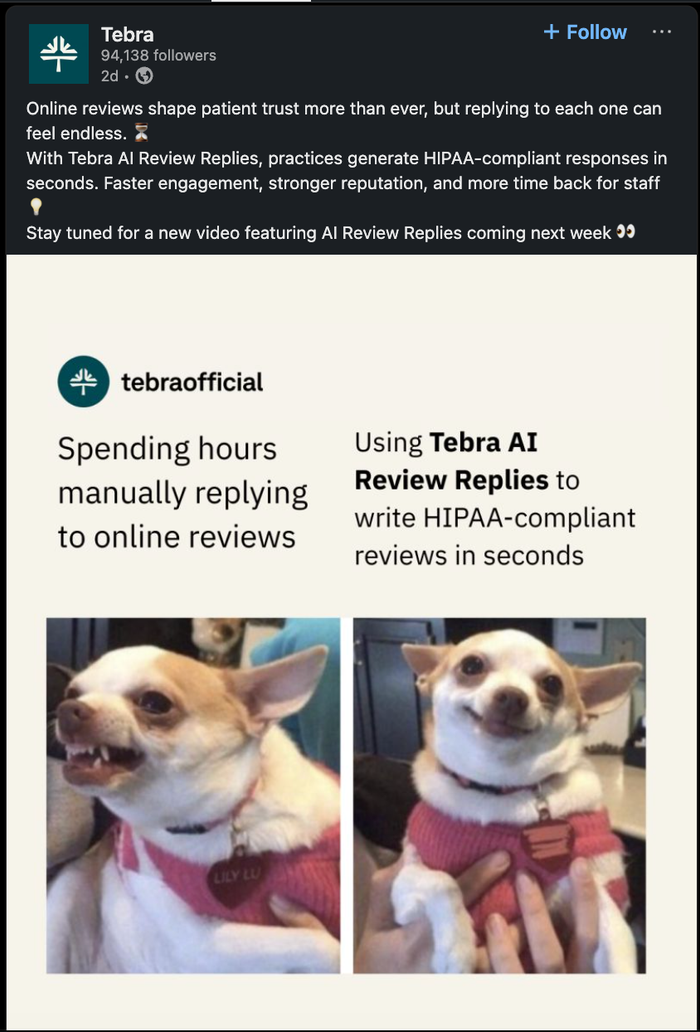Choosing how to advertise your business in 2025 can feel like a challenge. There are countless channels and campaigns to choose from, and there is only so much time and resources your small business can spare. With revenue on the line, you want to make educated choices instead of guesses that can cost your business dearly.
For small business owners wondering where to spend their marketing budget, we're bringing you the best channels and ideas you can try in 2025. You'll learn what each channel is best for and how much it costs to get started. Lastly, you'll get practical examples you can copy and learn from.
#1 Optimize your website for SEO (and AI)
Cost: free for essentials; SEO tools range from $20 to several hundred dollars per month.
You don’t need expensive tools or agencies to get noticed in 2025. Smart tweaks can lift your site in search results quickly. Start with:
- Structuring your content properly (clear title, logical H1/H2/H3 hierarchy).
- Checking your site speed with free analysis tools.
- Testing mobile compatibility to see how it performs on different devices.
- Using Google Search Console to track performance and keyword visibility.
If your business serves a specific area, focus on local visibility:
- Embed a Google Map on your contact page.
- Mention your city or region naturally across your site.
- Keep your business name, address, and phone number (NAP data) consistent everywhere.
Traditional SEO still matters, but it’s evolving fast. Artificial intelligence now shapes how people search… and how they find you.
LLMs like ChatGPT are becoming new entry points for discovery, while Google’s AI Overviews and AI Mode have changed how your brand appears in results.
You can adapt with a few free, high-impact steps:
- Add structured data (schema.org) using plugins for WordPress or Wix.
- Write in a Q&A format to help AI tools surface your content.
- Refresh your pages often; AI systems prioritize recent updates.
Do these well, and your site can achieve strong visibility – just like Capsule CRM, which ranks third for “small business CRM.”

Pro tip: To perform well in AI search results, handle the SEO basics first and use an AI visibility tool.
#2 Claim and manage your Google Business Profile
Cost: free
Your Google Business Profile (GBP) is often the first thing potential customers see: appearing in Google Maps results and the “local pack” listings that usually sit above organic search results. As mentioned in the SEO section, optimizing your GBP is one of the simplest, high-impact ways to boost local visibility. Now, we’ll briefly show you how to do it.
Setting it up takes about ten minutes, plus verification. Once claimed, you decide what people see: business hours, photos, contact details, and updates. That control helps shape your brand narrative and drives more clicks, calls, and visits.

But setup alone won’t move the needle. Google rewards active and engaging profiles. Here’s what you can do to stay visible:
- Keep your core business information accurate → name, hours, address, phone number, and website.
- Upload fresh visuals → your logo, workspace shots, team photos, and product or service images.

- Turn on features that invite engagement → messaging, booking links, and posts.
- Collect and respond to reviews → through email, QR codes, or in-person requests; report spam or fake ones promptly.
For local businesses, maintaining an optimized GBP is the most effective free way to attract nearby customers who are ready to buy.
We also have a local SEO checklist to help you cover even more ground with local search presence.
#3 Create automated email marketing campaigns
Cost: email marketing tools start at around $10/month for platforms like Transpond.
You’ve probably seen the numbers: email marketing often brings impressive returns when done right. But it’s also easy to miss the mark and end up with unopened messages or zero clicks. The difference lies in automation.
Instead of writing one-off emails for every new subscriber, build automated campaigns that run continuously based on the data already sitting in your CRM. These flows keep your communication consistent while increasing your odds of conversion.
Examples worth setting up:
- Welcome emails to introduce new subscribers and guide them to their next step.
- Abandoned cart reminders to recover lost sales opportunities.
- Post-purchase follow-ups with product tips, care instructions, or related offers.
- Educational drips with short guides, case studies, or downloadable resources.
Once your CRM connects with an email platform like Transpond, setting up these automations takes only a few steps:
- Define the goal → what you want the recipient to do after reading.
- Map the sequence → usually 3–5 emails spaced over a week or two.
- Personalize → use previous engagement or customer preferences to tailor the tone.
- Keep it clean → one call to action per email, consistent voice and design.
- Automate, monitor, and refine as results come in.
A good example is the Headspace welcome series: short, clear, benefit-driven emails that highlight what new users gain, reinforce their purchase, and introduce upsell options naturally:

Pro tip: Tie your automation to each subscriber’s behavior or lifecycle stage, not a static schedule. This keeps your outreach timely and relevant, and that’s exactly what turns generic emails into campaigns that drive real engagement.
#4 Become active on (relevant) social media channels
Cost: free (plus whatever you choose to spend on ads)
There are dozens of major social media platforms; enough to overwhelm any small business trying to stay visible online. But you don’t need to be everywhere. You just need to be where your audience actually spends time.
Start with research. Look at your audience’s age, interests, location, and income. Are they networking on LinkedIn, browsing communities on Reddit, or scrolling through TikTok during breaks? Pick the channel that fits their habits rather than the one trending this week.
You can also ask directly. When you survey existing customers, include a question about which platforms they use most and how. You might discover they prefer reading LinkedIn posts over creating their own, or that they rely on YouTube tutorials instead of short-form clips.
Next, define your goals.
- For brand awareness, focus on Instagram, TikTok, or YouTube.
- For B2B relationships or lead generation, prioritize LinkedIn or X.
Then, assess your resources. Beyond ad budget, think about your team’s capacity. Producing consistent content or running active channels like TikTok, X, or Discord demands dedicated time and creative skills.
Once you’ve chosen your platform (or two), start building your presence. Let’s say you’re a B2B healthcare company using LinkedIn as your main channel. Follow these five steps to get started:
- Optimize your page → add a clear tagline and banner image, fill in the About section, and ensure employees connect their profiles to your company page.
- Share value, not just updates → publish 3–4 posts weekly, mixing guides, case studies, video explainers, and industry commentary.
- Bring leaders into the mix → encourage executives to share insights and engage with others in their network.
- Engage intentionally → use tools like LinkedIn Sales Navigator to connect with ideal buyers, comment on their content, and start conversations.
- Use paid options strategically → run targeted LinkedIn ads to stay visible among high-fit prospects.
A strong example is Tebra, a healthcare platform that builds awareness through a blend of post formats on LinkedIn:

Its VP of Demand Generation also amplifies reach through personal posts that spotlight customer stories and success metrics:

Pro tip: if your schedule is tight, prioritize quality over quantity. A few thoughtful, consistent posts will outperform a daily content blitz. Repurpose what works: one good insight can become a short video, a quote post, and a blog snippet.
#5 Join online communities where your customers are
Cost: free
People rarely enjoy being sold to. They prefer conversations with peers who share their challenges, interests, or professional goals. That’s where online communities come in: places where your customers already talk, seek advice, and share insights.
A bit of research (see the previous section) can help you identify where they spend time. These communities might include:
- Subreddits like r/SaaS, r/startups, or niche industry spaces
- LinkedIn or Facebook groups
- Slack or Discord servers
- Quora threads or specialized forums
- Local groups on platforms such as Nextdoor
For B2B brands especially, Reddit has become a valuable place to engage. It’s not just because of its active user base: large language models like ChatGPT often pull Reddit data when generating answers, which means relevant discussions there can indirectly improve your online visibility.
Here’s how to participate on Reddit organically:
- Listen before speaking. Spend time reading subreddit discussions to understand what users care about and which topics perform well.
- Create a credible presence. Build an account tied to your brand but with a human touch. Include a short bio blending professional context and personality (e.g., “Work in SaaS, love analytics, here to share lessons”).
- Engage first, post second. Comment on other posts, answer questions, and contribute value before sharing your own content.
- Adapt your content to the platform. Turn articles into text posts with useful takeaways. For instance, instead of linking your CRM guide, summarize the insights as ��“5 mistakes small businesses make when choosing a CRM,” then offer a link only if someone requests it.
- Funnel traffic ethically. Use comments like: “I can share a template if anyone’s interested, just DM me.” Link only when it feels like a natural answer to a specific question. Track interest by offering free, ungated assets
- Be transparent. If you share templates, mention that they’re free and available via DM. Let others decide to reach out: never force it.
- Stay consistent. A short daily habit (20–30 minutes) of participating builds credibility far faster than one-off posts.
Here’s an example of a post that promotes a brand naturally. It shares insight, sparks conversation, and keeps the promotional element secondary:

Pro tip: aim to help, not to sell. Moderators are quick to spot overt promotion and remove users who break the community’s tone or rules. The most successful contributors focus on adding value first. The trust and visibility come naturally after.
#6 Participate in local events
Cost: from $100 to several thousand dollars
Digital marketing can take your business far, but some connections are still best made in person. Local events let you meet potential customers face-to-face and position your brand as part of the community.
Events worth considering:
- Community fairs and festivals
- Charity or fundraising gatherings
- Educational workshops
- Local networking meetups
- School or university events
You can attend… or organize one.
Imagine you run a digital marketing SaaS tool and want to host an educational workshop to attract new users. Here’s how to plan it from the ground up:
- Set a clear purpose. Decide what success looks like: whether it’s generating leads, boosting awareness, or simply connecting with your community.
- Pick your venue. Coworking spaces or local partner locations make great low-cost options.
- Choose a format. Sessions between 45 and 90 minutes tend to keep attention high.
- Build interactive content. Go beyond slides with visuals, real examples, and questions that spark engagement.
- Promote locally. Share posts in neighborhood Facebook or LinkedIn groups, put up posters in cafes, and reach out to local partners.
- Gather attendee info. Use Eventbrite or Google Forms for sign-ups so you can stay in touch afterward.
- Deliver genuine value. Keep the session practical and relevant to your audience’s daily work.
- Follow up quickly. Send resources, thank participants, and invite them to stay connected.
A brand that does this well is REI (Recreational Equipment, Inc.). They run free in-store events that teach outdoor skills directly connected to their products, building loyalty long before purchase:

Pro tip: If time or resources are limited, consider sponsoring local events instead. You’ll still get visibility and goodwill, minus the logistical load.
#7 Run Google Ads and target relevant keywords
Cost: whatever you decide to allocate. Small businesses usually spend between $1,500 and $3,000 per month.
All of the tactics so far can work wonders, but they’re not always predictable. That’s where Google Ads stand out. You control the spend, the targeting, and the outcomes, making it easier to justify your budget to a CMO or CFO.
Tools like SpyFu let you see what competitors are bidding on and how much they spend. Even without paid tools, you can gauge keyword costs directly in Google Ads to forecast ROI accurately.
Before you bring in a digital agency, it’s worth running a small test campaign yourself. The process is straightforward:
- Set one clear objective. Pick a single outcome – leads, sales, or demo sign-ups – and track it with Google Tag Manager.
- Keep tracking compliant. Add UTM parameters, confirm consent prompts for visitors in the EEA and UK, and apply tags to every key page.
- Select the right campaign type: Search (best for capturing active intent), Performance Max (reach across Google surfaces when you can supply strong creatives or product feeds) or Demand Gen (effective when video and visuals are your main assets).
- Structure your account. Use one campaign per goal, separate brand and non-brand traffic, name ad groups clearly, and group related keywords so data stays readable.
- Choose focused keywords. Begin with exact and phrase matches for high-intent searches. Add broad match only after conversions start coming in, so bidding has enough data to optimize.
- Set smart bidding and budgets. Start with Maximize conversions or Maximize conversion value to gather signals, then switch to Target CPA or Target ROAS once you reach consistent volume.
- Optimize weekly. First week, trim irrelevant search terms and pause weak assets. Then, during weeks 2–3, shift budget toward stronger ad groups, test new creatives, update headlines, and refine landing pages with high bounce rates.
If you’re using a CRM such as Capsule, track conversions from contacts and offline actions like store visits to see the full impact of your campaigns.
For inspiration, take a look at Linear’s ad targeting “Jira alternatives.” The copy directly addresses Jira’s biggest pain point – complexity – making the value proposition instantly clear.

Pro tip: Use exact match for intent and broad match with smart bidding for discovery. The balance keeps you visible to ready-to-buy users while expanding reach intelligently.
TL;DR: the best channels to promote your business to potential customers
Still not sure where to start? Here’s a quick recap to help you match each channel with your goals and budget.
- Go for SEO (and AI optimization) if you want steady, long-term visibility in search results and AI-powered answers — all with little upfront cost of a search visibility tool.
- Choose automated email campaigns if you need a low-cost, high-ROI channel to nurture leads and customers through behavior-based flows.
- Focus on your Google Business Profile if local exposure matters most. It’s free, visible in Maps and local packs, and ideal for businesses relying on walk-ins or service areas.
- Invest time in social media if you want to build awareness and credibility by sharing valuable content where your customers already spend time.
- Join online communities if your priority is trust and visibility among your target audience: think Reddit, Slack, or LinkedIn groups.
- Participate in local events if real-world conversations and face-to-face relationships help you build stronger customer loyalty.
- Run Google Ads if you need measurable, predictable results and want full control over your spend, targeting, and ROI.
Whichever path you choose, connect every channel through a CRM that keeps track of leads, interactions, and results. Otherwise, you’re marketing without memory.
With Capsule’s free plan, you get the foundation to store, track, and grow every relationship: right alongside your marketing efforts.




